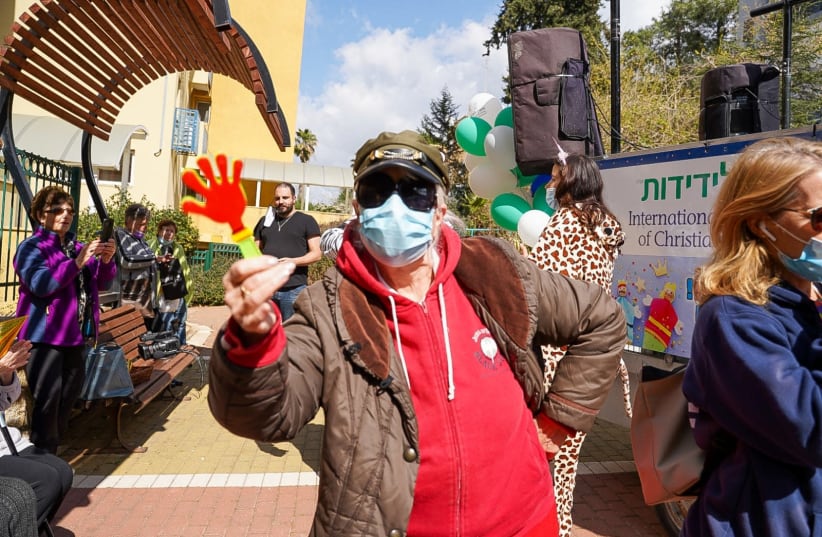The winter may be leaving but we are still left with a virus that accompanies us during another Purim. Social distancing is part of our lives for over a year, even if here in Israel, most people are vaccinated. We are cautious with kisses, hugs and other display of affection with friends, colleagues or family. Could our expression of affection be related to a cultural frame of mind? Are we repeating habits or gestures on automatic mode? And what if we could find a cultural solution to these forbidden kissing and hugging that bypasses our habits? And what if this coronavirus pandemic leads us to discover alternative ways to express our tenderness?
Our body movements, our small and big gestures to salute someone deserve close attention, and even more so during these absurd times in which we have been stuck for the last 12 months. Especially now we ought to find new ways to display our affection, both hygienic and cuddling. We are expected to practice physical distancing, but for our emotional well-being, we need to find gestures that comfort us in all safety. The challenge of this virus is also one of reinventing our behavior.
A hug between friends, a kiss on the cheek, cuddling with our grandparents, we all get closer to salute each other. In Israel, less than in other countries, the kiss is king. In France, friends, colleagues, flat mates have their cheeks touch for two, three, sometimes even four kisses. Even if in other countries kissing is a common salute, it is not the unique greeting. Some shake hands, others nod, smile or just a short “hi” will do. And then, there are countries or communities that forbid even the slightest touch between men and women. So how should we be in touch for those who wish to?
Each country had its way to deal with COVID. Unlike the first lockdown that kept parents and kids at home, during the second one, schools were open and some experts talk already about an expected baby boom during 2021, due to the parents taking a tender coffee break... The need for warmth and hugs is vaster than sexual encounters; it is the basis for our internal balance. In other words, we need human warmth to appease us and flourish.
Fortunately, all is planned in our body with a hormone spreading a wonderful feeling, the oxytocin. Five seconds of hugging stimulate the hormone; a 20-second embrace releases it into the body. Scientists even have graphs and charts to show the link between its chemical formula and joy of living. These molecules travel happily in our body! Not only does oxytocin increase our empathy and generosity, it diminishes the release of cortisol, the stress hormone. We witness all too well the suffering of isolated people, in cities or in elderly homes, when they were deprived of others. The pain of the absence of human warmth.
But this bitter truth was not unveiled by the current pandemic. The wonder of kisses is ancient.
In fairy tales like Snow White and Sleeping Beauty, the kiss brought the young girls back to the living. And long before these tales, King Solomon opened his Song of Songs with the kisses of the beloved, sweeter than wine. “Let him kiss me with the kisses of his mouth – for thy love is better than wine.” Rashi develops an interpretation about the kind of kiss the author could have meant. “If only King Shlomo would kiss me with the kisses of his mouth as of yore, because in some places they kiss on the back of the hand or on the shoulder, but I desire and wish that he behave with me as his original behavior, like a bridegroom with a bride, mouth to mouth.”
The most obvious slip of meaning from hugging to kissing is the French word EM-BRAS-SER. From holding between the arms – BRAS – the word acquired the meaning of kissing.
But all these examples refer to kisses face to face, lips near lips, arms holding each other for a hug where bodies meet chest to chest. No one recommends this yet.
HOW SHOULD we change our habits? The face is not the only one that could welcome kisses and hugs. Let us leave it aside and start our “kissing game,” a little less physical but still very warm and affectionate. Grandpas and grandmas want hugs, grandchildren long for their embrace. The back is a vast space for warm lips. A kiss of the granddaughter on the neck of grandma is full of sweetness. A grandson can kiss both his grandparents on the hair or the back of the head, and they can do the same. As children grow, sometimes they reach the region of our belly, so a belly/head hug is full of affection without endangering anyone. Strange at first, but good enough to stimulate the oxytocin in our system. It is a hug in times of pandemic.
Finally, let us rethink the hugs. In pictures, movies, videos, all over, hugging is again face to face. But is it the only way to hug? Snow monkeys in the cold mountains snuggle into each other and keep close. The little ones fold into the lap of the big ones, and the big ones, are keeping warm back to back. Let us imitate them with new hugs. The warmth is sensed and even a slightest touch activates our brain.
We can save our hugging and kissing as long as we keep in mind that now is the time to be creative. Let us find new ways to feel the same sweetness, just differently.
The writer is the president of the Institute for Intercultural Intelligence Training – www.ifdii.com – and author of the guidebook, Talking Without Saying It All.
